EFSEC (The State of Washington Energy Facility Site Evaluation Council Council) provides a “one-stop” siting process for major energy facilities in the State of Washington. EFSEC coordinates all evaluation and licensing steps for siting certain energy facilities in Washington. EFSEC specifies the conditions of construction and operation. If approved, a Site Certification Agreement is issued in lieu of any other individual state or local agency permits. EFSEC also manages an environmental and safety oversight program of facility and site operations.
The EFSEC website is :
Horse Heaven Wind Project
Project background:
On February 8, 2021 EFSEC received an Application for a Site Certification (ASC) from Horse Heaven Wind Farm, LLC proposing the construction and operation of the Horse Heaven Wind Farm project. The ASC proposes the construction of a renewable energy generation facility that would have a nameplate energy generating capacity of up to 1,150 megawatts (MWs) for a combination of wind and solar facilities as well as battery energy storage systems (BESS). The proposed project is located in Benton County, Washington. According to the ASC, if approved, the Applicant is anticipating commercial operation of the first Phase to be built by the end of calendar year (CY) 2023.
The Applicant is seeking permitting authorization for up to 244 turbine locations and two solar arrays with their capacity dependent on the approved location, technology, and power market interest.
The Facility will utilize wind turbines and solar photovoltaic (PV) panels to convert energy from the wind and sun into electric power which is then delivered to the electric power grid. Two battery energy storage systems are proposed that would have a storage capacity of up to 300 MWac (megawatt capacity) using lithium-ion batteries.null
____________________________________________________________________________________________________
Governor Inslee’s rejection letter directing EFSEC to rewrite the proposal
May 23, 2024
STATE OF W ASHLNGTON
– OFFICE OF GOVERNOR JAY lNSLEE –
Dear Chair Drew:
As an initial matter, I want to express my gratitude for the significant body of work that led to the Energy Facility Site Evaluation Council’s (Council or EFSEC) recommendation to approve the Horse Heaven Wind Farm Project (Project). However, pursuant to RCW 80.50.100, I am directing the Council to reconsider certain aspects of the draft site certification agreement (SCA) submitted to my Office on April 29, 2024, as outlined below, based on the existing record before the Council.
Before identifying specific matters for reconsideration, I want to reiterate the following statutory policy statement that, among other factors, must guide the Council’s work:
It is the policy ofthe state ofWashington to reduce dependence on fossil fuels by recognizing the need for clean energy in order to strengthen the state’s economy, meet the state’s greenhouse gas reduction obligations, and mitigate the significant near-term and long-term impacts from climate change while conducting a public process that is transparent and inclusive to all with particular attention to overburdened communities.
RCW 80.50.010.
Washington state faces the stark reality that without a rapid buildout of new clean energy generation and transmission, the dependability of our electricity grid is at risk. We must come to grips with the fact that we will need to adapt and accept relatively moderate changes to our physical landscape, in order to ensure continued, reliable electricity service.
Our State Energy Strategy shows electricity demand in Washington could grow by 13-20% over 2020 levels by 2030. By 2050, electricity load growth is expected to increase to 92% above the 2020 levels. At the same time, the Clean Energy Transformation Act prohibits use ofelectricity from coal-fired generation facilities to serve electric loads after 2025, requires carbon neutral electricity supplies starting in 2030, and requires 100% renewable or non- emitting electricity supplies by 2045. For these reasons, the siting and permitting of clean electricity projects is vital to addressing Washington state’ s power supply and clean energy requirements.
As it was originally proposed, this Project would provide 1,150 megawatts of electricity, approximately 5% ofthe new electricity generation needed in the next decade. For context, the region will need to build roughly twenty additional clean energy projects ofthis magnitude to meet Washington’s projected electricity load growth by 2035.
Indeed, for these reasons the Council’s statute makes clear that the siting and permitting of clean energy facilities is a critical priority for Washington:
It is the policy ofthe state of Washington to recognize the pressing need for increased energy facilities, and to ensure through available and reasonable methods that the location and operation of all energy facilities and certain clean energy product manufacturing facilities will produce minimal adverse effects on the environment, ecology ofthe land and its wildlife, and the ecology of state waters and their aquatic life.
It is the intent to seek courses of action that will balance the increasing demands for energy facility location and operation in conjunction with the broad interests of the public. In addition, it is the intent of the legislature to streamline application review for energy facilities to meet the state’s energy goals and to authorize applications for review of certain clean energy product manufacturing facilities to be considered under the provisions ofthis chapter.
RCW 80.50.010 (emphasis added).
In short, the statute directs the Council to balance the environmental impacts with bold action to meet our state’s pressing energy needs. To this end, the Council’s action should be based on the following key policies enunciated in its statute, which also emphasize the need for clean energy:
(1) To assure Washington state citizens that, where applicable, operational safeguards are at least as stringent as the criteria established by the federal government and are technically sufficient for their welfare and protection.
(2) To preserve and protect the quality of the environment; to enhance the public’s opportunity to enjoy the esthetic and recreational benefits of the air, water and land resources; to promote air cleanliness; to pursue beneficial changes in the environment; and to promote environmental justice for overburdened communities.
(3) To encourage the development and integration of clean energy sources.
(4) To provide abundant clean energy at reasonable cost.
(5) To avoid costs of complete site restoration and demolition of improvements and infrastructure at unfinished nuclear energy sites, and to use unfinished nuclear energy facilities for public uses, including economic development, under the regulatory and management control of local governments and port districts.
(6) To avoid costly duplication in the siting process and ensure that decisions are made timely and without unnecessary delay while also encouraging meaningful public comment and pariticipation in energy facility decisions.
RCW 80.50.010.
As I have outlined here, the Council’s statutory framework emphasizes the importance of permitting and siting clean energy facilities. While it is incumbent upon the Council to minimize environmental and other impacts of these projects where feasible, the critical need for rapid and large-scale growth in our state’s clean energy generation capacity should guide the Council’s consideration of conditions or limitations that would limit the scale of proposed clean energy projects.
With these general considerations as a background, I tum now to my evaluation ofEFSEC’s recommendation.
In order to review the Council’s recommendation and the extensive record in this matter, I convened a team of seven advisors including policy area experts, my general counsel, and two Assistant Attorneys General. We met a number of times, in some cases on a near daily basis as we delved into the record materials. In addition, we consulted with the Council’s technical staff for assistance in quickly locating information in the extensive record.
In General
I find that the extensive record compiled by the Council provides robust detail as to the nature and complexity of the potential impacts of the proposed Project and identifies a range of measures to mitigate to various degrees these potential impacts. The record is robust and satisfactory from my perspective for the purposes of siting and permitting the proposed Project, and I concur in the Council’s determination that the Project is consistent with the County land use plan and zoning ordinances per Orders 883 and 892.
However, I am directing the Council to reconsider the conditions and mitigation in its recommendation in favor of an approach to mitigation that is more narrowly tailored to the specific impacts identified. Such an approach would seek to limit the conditions to those measures that are reasonably and feasibly consistent with achieving the full or near-full clean energy generation capacity o f the proposed Project.
For example, the Council recommended excluding turbines from the micrositing corridor identified as “Class 3 Impact” in Figures 2-5 and 2-6 of the Final EIS in order to minimize multiple “compounding” impacts.1 However, I find that that this approach of eliminating a large swath of the proposed turbine locations to achieve a generalized reduction in impacts across a number of categories takes an overly broad approach to addressing the very different types of impacts at issue. This results in a dramatic reduction in the overall scope of the proposed Project. The outright prohibition of turbine locations should be replaced with mitigation in the form of operational conditions that allow for build-out of the vast majority of the proposed Project.
On reconsideration, the Council should review the existing, robust record and design mitigation requirements consistent with the structure and approach that I have outlined here. The goal of the mitigation is to reduce the impacts wherever reasonably feasible. However, significant impacts may be accepted as part of this vital Project where they cannot be reasonably mitigated. Based on my review of the record and the potential impacts, mitigation measures that substantially reduce the generation capacity of the proposed Project should not be required.
Further, I specifically direct the Council to reconsider the mitigation requirements in light of my observations and direction in a number of key specific areas, including mitigation for impacts to wildlife, habitat, visual, and cultural resources.
Wildlife and Habitat
Based on my review of the record it is clear that with narrowly tailored mitigation, impacts to wildlife and habitat can be adequately mitigated including but not limited to ferruginous hawks, pronghorn antelope, several species of bats, and ground squirrels. The Council should reconsider, however, certain mitigation measures that are overbroad and would unnecessarily result in limiting the generation capacity of the Project such as mitigation for the ferruginous hawk, as well as the habitat mitigation measures included in the draft SCA.
The record shows that substantial disturbance from agricultural and residential land use has caused a significant decline in the ferruginous hawk population at the Project site and calls into question whether the ferruginous hawks will return given the considerable, permanent changes to their habitat. The sad reality is that the ferruginous hawk population has declined to minimal levels at the site over many years, due to various factors including agricultural and residential land use decisions that pre-date this Project. In fact, the record reflects that not a single ferruginous hawk has been seen nesting in the Project area in the last 5 years. As a life- long birder, this is not a fact that is pleasant to acknowledge.
The location and number of turbines the Council recommended to be removed from places where generation capacity is highest is based on the Council’s assessment of minimizing
impacts to ferruginous hawk habitat in the Spec-5 mitigation provision. Given the currently existing habitat conditions for hawks, and the corresponding impact that any reduction of the Project is likely to have on generation capacity, it is important to focus hawk protection requirements to those times and places where hawks are present. Again, the impact mitigation approach must be narrowly tailored, based on the best available science and ongoing site surveys.
Rather than excluding large areas of the wind turbine micrositing corridor based on radii of historic hawk nest sites, I direct the Council to consider, at a minimum, the following alternative mitigation approaches: First, regarding habitat mitigation, exclusion of all sage shrub-steppe and rabbitbrush acreage from the micrositing corridor for turbines, as well as seeking ways to require or enlarge sage shrub-steppe habitat mitigation through conservation easements and other habitat’protection requirements both on and off the Project site; second, consider siting restrictions that can be eliminated and replaced with operational curtailment for individual turbines, and also suspension of construction activity, whenever currently existing ferruginous hawk activity is detected within 2 miles of that turbine during the late March through late July nesting and fledgling periods each year; third, I direct the Council to consider requiring the applicant to monitor ferruginous hawk activity as well as turbine strike mortality during the life of the Project and make adjustments to operation and construction activities as needed.
Additionally, rather than prohibiting solar arrays and battery storage within 0.5 miles of historic hawk nests, the Council should consider use of alternative installation and siting approaches, where physically and financially feasible, and/or exclude sage shrub-steppe and rabbitbrush acreage from the micrositing corridor for solar arrays. Elimination of this type of habitat from clean energy installation is not the policy of Washington state but is acceptable in this Project as it represents a de minimis reduction in generation capacity and provides advantages in this unique circumstance.
Cultural Resources
• I appreciate the care taken to fulfill the Council’s duty to consult with affected Tribes and the state Department of Archeology and Historic Preservation. These efforts identified tribal resources or rights potentially affected by the proposed energy facility along with ways to avoid, minimize, or mitigate any adverse effects on tribal resources or rights in accordance with RCW 80.50.060. I also acknowledge and thank the applicant for working with the Confederated Tribes of the Umatilla Nation and the Yakama Nation to identify physical traditional cultural resource sites and avoiding siting turbines and solar arrays at those sites in its Final Application for Site Certification (ASC).
I direct the Council to focus mitigation on specific and narrowly tailored approaches that do not reduce the generation capacity of the Project. The Council should explore requiring the applicant to attempt to seek access agreements for the Yakama Nation to access highest priority, physical traditional cultural resources within the leased prope1ty boundary, including previously inaccessible sites due to it being private property. I direct the Council to develop mitigation based on the record to address this issue that will be substantially consistent with the full scope ofthe Project.
Visual Impacts
Wind turbines are a fairly common occunence across the state. While I respect the views of those who do not appreciate seeing turbines on the landscape, I also believe all sides would agree that continued and reliable electricity service is imperative. Given the state’s clean energy needs and requirements, adopting a zero-tolerance policy to visual impacts is inconsistent with state statutes. I have carefully reviewed photographs and perspectives in the record that depict the visual impacts on residential neighborhoods, and it is clear that turbines will be visible only from a distance and none of the turbines will loom over anyone’s home. The record shows that there will be visual changes as a result of the Project from various vantage points, but that these changes are both limited and subjective in nature.
Recreation Impacts
I agree with the Council’s decision to require the applicant to develop an adaptive safety management plan to allow continued recreational activities without significantly impacting the generation capacity of the Project as proposed in the Final ASC. No reconsideration of this matter is required.
Fire and Firefighting Impacts
The Council found, and I concur, that the Project does not increase risk of fire but could impact the way certain fires are fought. The Council appropriately required the applicant to address these issues through emergency planning and mitigating conditions, including operational curtailment when necessary. I find that the Council adequately considered the risks offire and included appropriate hazard mitigation. No reconsideration ofthis matter is required.
Conclusion
I hereby direct the Council to reconsider its recommendation in light ofthe foregoing and based on the existing record. I further direct the Council as follows: Throughout the evaluation o f specific mitigation measures and wherever possible, time-limited operational and flexible requirements should be favored rather than overbroad turbine or solar placement exclusions. This will more directly provide needed mitigation where it is feasible and largely consistent with the proposed Project’s purpose and need. For your convenience, attached as Appendix A is a non-exclusive list ofpotential mitigation measures for the Council’s consideration.
The Council has deliberated on this Project for three years and developed an extensive record sufficient to make an informed decision on more appropriately, nan·owly tailored mitigation measures. It is imperative that the Council conduct its reconsideration expeditiously, as required by RCW 80.50.100. It is therefore my expectation that the Council will resubmit the draft certification agreement, with appropriate amendments, for my consideration within 90 calendar days o f the date o f this letter.
It is my film belief that with a narrowly tailored impact mitigation approach the Council can-and should-approve this Project in a manner that allows for maximum generation capacity largely consistent with the scale o f the -Project as proposed in the Final Application for Site Certification. I strongly encourage the Council to return to me their approval ofthis Project application that appropriately prioritizes the state’s pressing clean energy needs.
Sincerely,
Jay Inslee
Governor
_________________________________________________________________________________________________
_____________________________________________________________________________________________________
_____________________________________________________________________________________________________
Click on this link to Comment
1. Arrow down past the light blue listed libraries box
2. Click on the light green horizontal box for the “Draft EIS documents.” Concentrate on the area/s that affects you the most and comment on them/those.
3. Click on the dark green horizontal box to “Submit your comment.”
EXAMPLE DEIS COMMENT: (Use this format: IRAC – Issue, Rule/Reason, Application, Conclusion)
Issue: In the DEIS for the Horse Heaven Wind and Solar Project, Scout Clean Energy’s failure to provide specific location of every wind turbine makes it impossible to conduct a noise study for each turbine.
Rule/Reason: Noise from wind turbines has been documented to have negative impacts on human and animal health.
Application of Rule: Try to include photos, YouTube videos, references, links, etc. Example link: https://www.youtube.com/watch?v=ID2dG0JIJXA
Conclusion:
1. Scout Clean Energy must be required to submit a site plan showing the exact location of each turbine to allow a noise study for each turbine.
2. Require a 360-degree, 6-month noise study for each turbine conducted prior to application approval.
3. Turbines that produce detrimental noise to nearby residents and wildlife are to be relocated or removed prior to approval of the project.
_____________________________________________________________________________________________________
December 3, 2022 update; the following was copied from the EFSEC website or was discussed at the November 2022 EFSEC meeting.
Final Timelines for the Horse Heaven Wind Farm Project:
1. The DEIS should be released by “early fall”, probably early December 2022
Scout petitioned and EFSEC approved that the deadline for the DEIS be extended to December 8, 2022.
Horse Heaven Draft Environmental Impact Statement Overview (Presented during EFSEC meeting on 11/15/2022 by Amy Moon)
What is an Environmental Impact Statement (EIS):
- Provides information about the adverse environmental impacts of the proposal to both the built and natural environment.
- Provides an opportunity for public review prior to the Final EIS.
- Decision-makers use the Final EIS along with other information to decide whether to approve, approve with conditions, or deny the proposal
Note: 7 WA State agencies provided comments for the DEIS but no Indian tribes (they will communicate their position directly to the State: government to government interaction).
Note: Scout is looking for maximum flexibility for the project, with 3 solar farms in different locations, possibility of battery storage, 244 shorter turbines at 450 ft vs. a mix of fewer turbines but taller at 650 ft.
How is the Draft EIS organized?
Note: There is a new chapter looking at the socio-economic impact of the project: does it affect especially lower income communities?
Some Pointers for Reviewing the Draft EIS
Understand the overall organization of the document:
• 9 Chapters
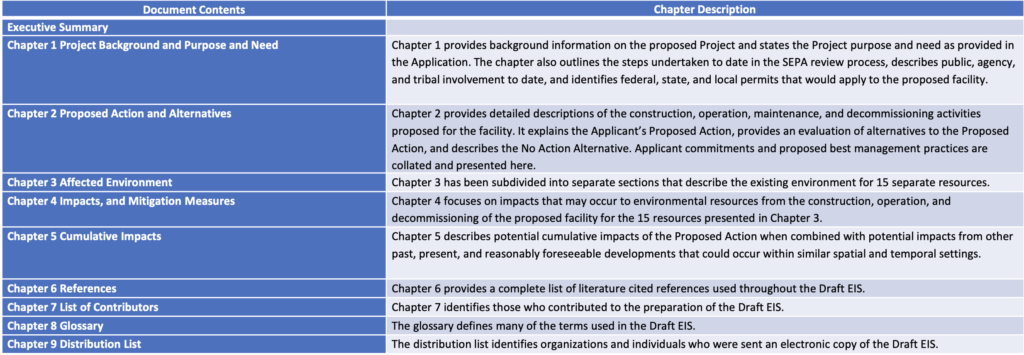
- Subsections in Chapters 3 and 4 on affected environments and impacts and mitigation.
- Appendices.
Commenting on the Draft EIS
- Useful comments which can affect the content of the final EIS: be specific, is the information in the DEIS correct, is the impact local or wider.
- Some topics are outside the scope of the EIS: for example commenting on fossil fuel use.
2. The public comment period for the DEIS has been extended to 45 days, probably mid-January, maybe February 2023.
The Council holds public hearings on the draft EIS. If it is a joint federal/state EIS, joint hearings are held. At the same time the EIS is developed and related public hearings on the draft EIS are held, adjudicative proceedings may take place. However, the adjudicative proceedings must be finalized before the Council issues the final EIS.
Adjudicative Proceedings and Permits Review
EFSEC’s certification process calls for the Council to hold hearings on the proposed project to allow the applicant and opponents to present information to support their cases. Council rule requires the hearings to be conducted as Adjudicative Proceedings. Land use preemption issues may be heard during these proceedings.
The Council’s adjudicatory proceeding is a formal hearing process similar to a courtroom proceeding, where the Council hears from the official “parties” to the proceedings. By law all state agencies and local governments with members on the Council are considered parties to any Adjudicatory Proceeding before the Council. An agency wishing to be an active participant in the proceedings may be represented by the agency’s Assistant Attorney general during the proceedings. The state Attorney General’s Office appoints a Counsel for the Environment to be a party in the proceedings representing the public and its interest in protecting the quality of the environment.
Other interested persons; tribes; groups; or local, state, or federal agencies may petition the Council to become interveners in the proceedings. The Council considers the intervener petitions and determines whether to grant intervener participation based on the project’s impact on the concerns of the interveners. If denied party status, petitioners may ask the Council for administrative review if they disagree with the Council’s decision.3.
The adjudicatory process after the release of the DEIS will be led by Judge Adam Torem.
3. Intervener: Another public comment period for expert witnesses by March/April/May 2023.
Benton County and the State agencies will have a seat at these hearings.
Changes between the Draft EIS and the Final EIS are expected and normal
A supplemental DEIS will be issued to address the major new issues.
During the EIS process,
- Projects/applicants respond to the identified environmental impacts
- The project description, applicant commitments, and agency–identified mitigation typically evolves.
Final Environmental Impact Statement
A Final EIS includes:
- Responses to public comments
- More analysis, when warranted, responding to those comments
- New information/analysis responding to project changes
- More or refined mitigation
4. Final vote on the HH wind farm project by July 2023
Council Considerations
When the adjudicative hearings have concluded, the Council takes time to consider the information collected during the proceedings. After its deliberations the Council writes an administrative order containing the Council’s findings of fact, conclusions of law, and, if it finds the project should proceed, a recommendation to the Governor to approve the project. The Council has the option of issuing a preliminary or draft administrative order allowing the parties to take exceptions to the findings. The Council then reviews any exceptions and issues a final administrative order.
- EFSEC led by chair Kathleen Drew will vote on the HH wind farm project and make a recommendation to Governor Inslee
- There are 5 voting members: Fish & Wildlife, Utilities & Transportation, Ecology, Commerce, Natural Resources, and Chair Kathleen Drew. Benton County representative Ed Brost will also cast a vote.
Recommendation to the Governor
If the Council determines the project should be recommended to the Governor, it develops an administrative order on recommendation (including any recommended preemption of local land use regulations) and a draft Site Certification Agreement to be signed by the Governor. The SCA has all of the environmental, social, economic, and engineering conditions the applicant must meet for construction and operation throughout the life of the project.
If the Council determines the project should not be recommended to the Governor for approval, the final order explains the Council’s decision.
5. Governor Inslee makes a final decision (after July 2023)
The Governor has 60 days to consider the Council’s recommendation and can take one of the following actions:
- Approve the Council recommendation and execute the draft SCA
- Reject the application
- Direct the Council to reconsider certain aspects of the project and draft SCA
Note: Governor Inslee already indicated in interviews that he will approve the project.
_____________________________________________________________________________________________________
December 1, 2022
Paul Krupin has looked at the application for the Whistling Ridge windfarm project and what it can teach us about the EIS process. The application was filed in 2009 and the project is still on hold.
“This link is worth reading in order to gain a good understanding of the way EFSEC looks at and resolves contested issues. This is the Final Adjudicative Order Resolving Contested Issues. It shows the importance of building solid comments into the public record through the permitting and SEPA Process.
https://www.efsec.wa.gov/sites/default/files/096000/02560/20111006_868.pdf
There is textual language in here that allows us to mirror the way they present issues. It is a very clear indication of the type of testimony we need in the record and in the public hearing comments.
The role of Benton County is the adjudicative proceedings is exceptionally important. So once again, studying the county’s land use regulations are important.
The presentation and analysis of the visual impacts (on pages 19-22) is very very insightful. It is here we see the court’s rationale for its conclusion that wind turbine areas be excluded where they would be prominently visible.
While we do not have a Scenic Area, we have many tens of thousands of people who live and own properties and homes. We will have to identify, fortify and then champion their rights against any visual intrusion.
On page 22, you will see a specific Counsel suggestion adopted to “eliminate the portion of the A Corridor containing Turbines A-1 to A-7 from the approved siting area. The same is found for the entire C corridor of wind turbines.
The turbines are determined to be “impermissibly intrusive”.
There is also language that talks about impact on residences and noise.
The Viewing Siting Analysis table on page 23 has three options above and beyond the Option 0. We need to develop this for the HHH project and present it since all we have so far is an Option 0. We need to designate areas that HHH does not yet have identified.
It is also worth reading and understanding the analysis of wildlife and habitat on pages 23 to 27. You can see how much weight the court gives to the various agencies and their recommendations. You can also see how they set up a mitigation process and set of mitigation standards. In particular, look at the creation of the mitigation parcel. On page 27
To get a fast overview, here is the Conclusions section. This is a snapshot and I was unable to open the text to copy it verbatim”.
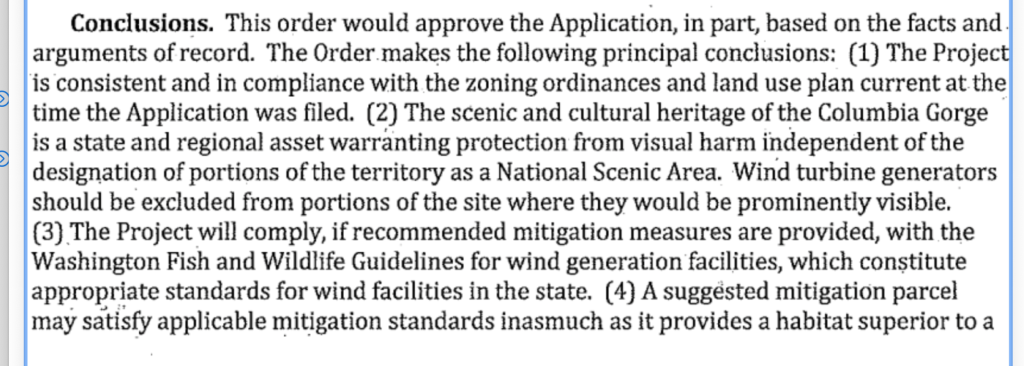
__________________________________________________________________________________________________
EFSEC Meeting Notes, courtesy of Pam Minelli
May 17, 2022
Note: Ed Brost, Benton County representative, not present.
Derek Sannerson of Department of Agriculture present.
Amy Moon (EFSEC Staff) re SEPA Report/ DEIS:
– EFSEC staff continues to work with Consultant Golder and Department of Fish and Wildlife re a mitigation plan
– (No date given for completion of DEIS (Draft Environmental Impact Study))
Amy Hofkemeyer re the Draft Land Use Order:
– EFSEC Staff recommends approval of the Draft Land Use Order at today’s EFSEC meeting. See below:
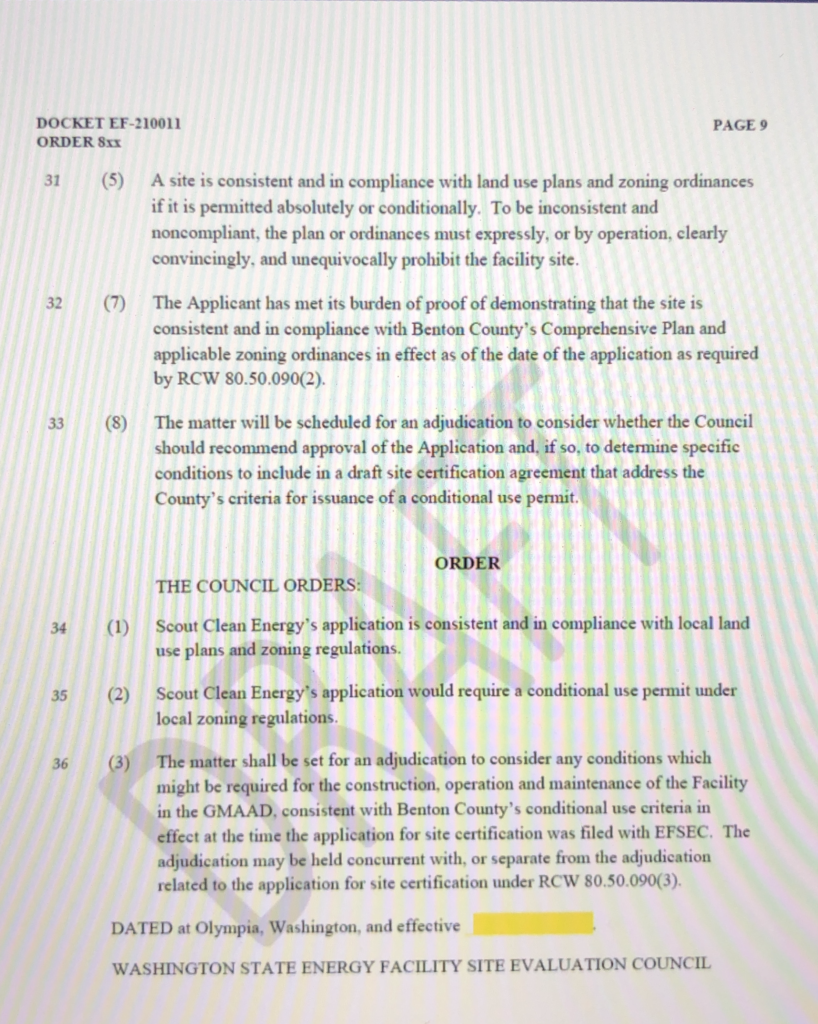
Discussion re the Draft Land Use Order:
Chairman Drew commented:
- Land Use Consistency Order is one part of the process to determine if the plan for HH Wind Farm is consistent and compliant with overall land use in Benton County. If there are conditions, they will come up during adjudication.
- The next step is adjudication.
- Read p9 items 1-3 of Draft aloud and asked for comments.
Per John Thompson, Assistant Attorney General:
-Re #2 of above Draft, The EFSEC process takes the place of requiring a conditional use permit from Benton County to site HH Wind/Solar Farm in an agricultural zone. Therefore, Scout does NOT also need a conditional permit from Benton County.
-Conditional use will be “taken up” during adjudication hearing. The process will be similar to the county process for granting a conditional use permit.
-The EFSEC process is required to take county law (zoning)/any conditions in account during approval process.
Other discussion:
-Zoning ordinances are adopted as part of the local/county comprehensive plan. These ordinances state what land uses are allowed outright and what uses must apply for a conditional use permit to determine if they are compatible with the local/county land use (comprehensive) plan.
-Allowable uses need no permit.
-Wind and solar farms do need a conditional use permit in this agricultural zone.
Chairperson Kathleen Drew requested a roll call vote to approve the Draft Land Use Order. All present voted to approve.
Amy Hofkemeyer re Adjudication Hearing:
-EFSEC staff working with Judge Torem on dates, details of the Adjudication Hearing. More to report at next (June) Meeting.
_____________________________________________________________________________________________________
WASHINGTON STATE ENERGY FACILITY SITE EVALUATION COUNCIL
TUESDAY, JANUARY 18, 2022 1:31 P.M.
Virtual Special Meeting Verbatim Transcript of Proceedings (Partial, Horse Heaven Project)
Chair Drew: And while I have you here, report on Horse Heaven Wind power — Wind Project, please.
MS. MOON: Okay. For the record, this is Amy Moon providing an update on the Horse Heaven Wind Project.
EFSEC staff continue to work on the preparation of the draft environmental impact statement, otherwise known as a DEIS. We were working on that in both November and December as well as today.
The work has included review of our contractor holders work on drafting the DEIS, as well as continued coordination regarding wildlife and habitat mitigation with the Washington Department of Fish & Wildlife and the Horse Heaven applicant.
The discussions have included impact analysis as well as opportunities for impact avoidance and minimization of impacts that will support the applicant in developing an updated mitigation plan.
EFSEC received responses to data requests regarding habitat, noise, service water, vegetation, and wildlife. And these data requests were to the applicant.
The information received from the data request is being used to inform the DEIS preparation as well as the habitat and wildlife mitigation discussions.
Additional noise baseline measurements near residential areas were included in a data request. And the applicant have been actively pursuing the additional measurements.
Does the Council have any questions?
CHAIR DREW: Are there any questions from Councilmembers? Okay. Thank you.
MS. MOON: Okay. And then we’ve also received a letter from the applicant regarding an extension of their application review period. Ami Hafkemeyer has more information on that.
CHAIR DREW: Okay. Ms. Hafkemeyer.
MS. HAFKEMEYER: Thank you, Ms. Moon. Good afternoon, Chair Drew and Council. For the record, this is Ami Hafkemeyer.
On January 10, 2022, EFSEC Staff received a letter from Scout Clean Energy, the applicant, requesting that the review of the application for site certification, or ASE, be extended ten months to December 8, 2022. This letter is available in the council packet for your review EFSEC statute states in the Revised Code of Washington, or RCW 80.50.100, that the council shall report to the governor its recommendations as to the approval or rejection of an application for certification within 12 months of receipt of the council by the council of such an application or such later time as is mutually agreed by the council and the applicant.
EFSEC received the application for the Horse Heaven Wind Farm on February 8, 2021. And the 12-month time frame would conclude — would conclude on February 7, 2022, unless an extension is agreed upon by the council and the applicant.
As mentioned in the update from Ms. Moon, the work for the EIS is heavily underway. And staff are also continuing to coordinate with the administrative law judge, Judge Torem, to schedule the adjudicative proceedings. Staff and the applicant have coordinated on what we feel is an appropriate time frame for such an
extension and recommend that the council approve the request.
Are there any questions from Councilmembers?
CHAIR DREW: Are there questions from Councilmembers?
MR. BROST: This is the Ed Brost. What is the extension request, for how long? Did you say ten
MS. HAFKEMEYER: It would extend the review period for an additional ten months to December 8, 2022.
MR. BROST: Thank you.
CHAIR DREW: Any other questions?
Is there a motion to approve the extension request for ten months?
MR. SANDISON: So move. This is Derek Sandison, so move.
CHAIR DREW: Thank you. Second?
MR. LIVINGSTON: Mike Livingston, I’ll second
CHAIR DREW: Thank you.
_____________________________________________________________________________________________________
Verbatim Official Transcript of Monthly EFSEC Council Meeting on HH Windfarm Project from 9/21/2021
And next for our update, Horse Heaven Wind Project, Ms. Moon?
MS. MOON: Again, good afternoon, Council Chair Drew and Councilmembers. For the record, this is Amy Moon providing an update on the Horse Heaven Wind Project. EFSEC wants to provide you, the Council, with the status on the Draft Environmental Impact Statement or the DEIS. We want to provide an update on that preparation effort.
As you know, following the applicant’s withdrawal of their request for the expedited processing of the application on March 29th, 2021, a determination of significance scoping notice was issued on May 11th. The scoping notice announced a 30-day public comment period, which ended on June 10th of 2021. EFSEC Staff and their consultant worked on tracking and reviewing the comments, which included 361 public comments. In addition, EFSEC received
approximately 17 comment letters from agencies and 9 tribes. During that same timeframe, EFSEC’s consultant was also preparing several data requests for the applicant. The 134 data requests covered a wide number of topical areas including habitats, wildlife, vegetation, air, noise, recreation, water supply, land and shoreline use, cultural historic, esthetic, earth, service water and wetlands, energy and natural resources, light and glare, environmental health, heat dissipation, transportation, stormwater, and finally wastewater. These requests were provided to the applicant in three packages between May 27th and July 22nd of 2021. The applicant subsequently provided responses beginning July 1st, and the most recent response was received yesterday on September 20th.
The applicant is still preparing a few remaining responses associated with cultural resources and visual simulations, which falls into esthetics. Between April 4th, 2021, and now, EFSEC has also been working with our consultant to define the parameters providing the draft EIS. Those parameters that we’re working on now defining are the final scope of elements of the environment that will be examined in the draft EIS, the alternatives that will be examined, how impacts will be analyzed using an impact rating system, identification of reasonably foreseeable projects for the cumulative effects analysis, the overall organization of the draft EIS, the draft EIS document review period, and an overall timeline. Most of these decisions are interconnected to some degree or another. For example, the scope of the elements of the environment and determination of alternatives could not be made until public scoping was completed and all comments were considered. As indicated, the timeline is affected by all these preliminary pieces that are important steps to completing the SEPA process. EFSEC Staff continue to coordinate with the applicant on responses to data requests and clarifications regarding the application for site certification. This coordination and completion of these interim tasks are important in producing an informative DEIS for the Council and the public.
In the meantime, we are working to identify the timeframe of major milestones so we can keep the Council and applicant apprised of these as work progresses.
Does the council have any questions?
Chair Drew: Are there questions from Councilmembers?
MR. LIVINGSTON: Chair Drew, this is Mike Livingston. I’m curious, so as scoping comments and the responses from the applicant are put together, when — when would you anticipate us, as Councilmembers, being able to view some of these draft documents? Or are they available today and I just haven’t seen them yet?
MS. MOON: So I guess I’m misunderstanding. What draft documents? Do you mean the full draft EIS or do you mean comments that public and agency —
MR. LIVINGSTON: Yeah, the — the — yeah, the scoping comments that came in from the public as well as the responses from the applicant.
MS. MOON: So the responses we have from the applicant are from the data request. So we asked them for additional information, and those are posted on the public EFSEC website. And then comments are also posted on that public website.
I don’t — I don’t know that they have been posted to a Council share point site for review, but they are on the public Horse Heaven website.
MR. LIVINGSTON: Okay. That’s — that’s what I was asking for, Amy. Thank you.
MS. MOON: You’re welcome.
CHAIR DREW: Thank you.
Are there other questions from Councilmembers?
Thank you, Ms. Moon. And it’s a complex process with a lot of information, work, and gathering and — going on. And I know that we will have more information yet at the next monthly meeting. So thank you for your report.
___________________________________________________________________________________________________
Verbatim Official Transcript of Monthly EFSEC Council Meeting on HH Windfarm Project from 8/17/2021
CHAIR DREW:
And now we move to Horse Heaven Wind Farm, Ms. Moon.
MS. MOON: All right. Thank you again.
Good afternoon, Chair Drew, Councilmembers, on the new project, Horse Heaven. This is Amy Moon again. EFSEC Staff continue to work with the applicant and our contractor, Golder, on data requests. The response to Data Request No. 2 was received on August 16th and is under review. Data Request No. 3 was submitted to the applicant July 22nd and a response is due August 23rd.
This request asks for information and clarification on noise, wildlife, and recreation. The
data requests inform the SEPA scoping process and, again, SEPA is the State Environmental Policy Act. So the data requests inform the SEPA scoping process as well as preparation of the draft environmental impact statement, which is also known as an EIS. Part of the data gathering effort has included meetings with EFSEC, EFSEC SEPA contractor, which is Golder, and the applicant to discuss and clarify each data request. The responses to the three data requests are an important part of preparing the draft EIS as they can close information gaps as well as provide integral information on the project proposal and alternative analysis. A site visit to the project area was conducted on July 23rd with the Washington Department of Fish and Wildlife, or WDFW. The applicant, EFSEC, and EFSEC contractor, Golder, participated in the site visit. The site visit was conducted at the request of Fish and Wildlife to assist in their review of the project proposal. The site visit included potential wildlife corridors, examples of existing wildlife habitat such as shrub step, grassland, and habitat for species of concern, as well as canyons and proposed utility crossings. EFSEC continues their work on SEPA scoping and will prepare a recommendation to the EFSEC SEPA responsible official on resource topics to be considered in the draft environmental impact statement. The scoping decision by the SEPA responsible official will inform the overall project schedule development. Information received in the application, responses to data requests, public comments during the SEPA scoping comment period, and agency comments are being used to prepare the recommendation to the EFSEC SEPA responsible official. And once the scope is determined, the draft EIS, also known as the DEIS, will be prepared. As stated in the July 20, 2021 Council update, Staff are anticipating a 30-day public comment period for the DEIS. Additionally, Staff are coordinating with Judge Torem to schedule the next steps for an adjudicative process.
Does the Council have any questions?
CHAIR DREW: A couple of questions I have. First of all, you mentioned the data requests. Those —
are those available for the public to see?
MS. MOON: Yes, those are on the EFSEC Horse Heaven Wind Project for the public to see. You go to the tab that’s for SEPA, I believe, and they’re on there. So the — the request submittals are there as well as the response to Data Request 1 and the response to Data Request 2.
CHAIR DREW: So I know it’s — it’s challenging for people who are interested in the project to follow along a little bit, but that is one way to follow along because there’s a period of time here where we really have to delve into all the questions that the public has raised and the information in the application in order to prepare draft EIS so the public can comment on. So all of that work is going on, but one way the public can follow it is through the data requests, and then we will have more information when the SEPA-responsible official, which is Ms. Bumpus, makes a determination of — of the information that we’ll be requiring in the draft EIS. Did I misstate anything there, Ms. Moon?
MS. MOON: Well, for what Sonia Bumpus will be doing is determining the resource topics that are going to go into depth in the draft EIS.
CHAIR DREW: Okay.
MS. MOON: And the data request certainly will give an indication of what those topics are most likely to be.
CHAIR DREW: Okay. That is very helpful. And let’s see, did I have any other questions?
Are there questions from Councilmembers?
MR. LIVINGSTON: Chair Drew, this is Mike LIVINGSTON
CHAIR DREW: Yes, go ahead.
MR. LIVINGSTON: I don’t have a question, I just want to thank and say I appreciate the opportunity that’s been provided by EFSEC Staff and the project proponent for WDFW staff to get out there. There’s a — you know, this is a very large project and there’s lots of considerations to be analyzed, particularly related to wildlife and habitat corridors. So really appreciate that opportunity that that was provided to the Staff and just wanted to acknowledge that. So thank you.
CHAIR DREW: Thank you. Thank you, yes, there is a lot of work behind the scenes that’s difficult for people to see as — as they follow along with this.
The other comment I wanted to make is we talk about the adjudication, which won’t take place until after we receive the draft EIS; is that correct,
Ms. Moon?
MS. MOON: So I’m going to have to defer to Ami Hafkemeyer on adjudication, because to — to be very telling, I have not gone through that process as an EFSEC Staff member, but — but Ami has, and she’s been very involved in setting that up.
CHAIR DREW: Okay.
MS. HAFKEMEYER: Thank you, Chair Drew and Ms. Moon. We are currently working with Judge Torem to set a schedule and put a plan in place for the adjudicative process. And based on past experience, we found that it is most helpful for parties to the adjudication and the Council for the adjudication to occur after the draft EIS has come out. And so that is our intent, but there are activities that need to takeplace prior to the adjudication, and so we are working on scheduling those activities as well with Judge Torem.
CHAIR DREW: Okay. Thank you. Thank you very much. That, I think, helps explain the process we’re in and hopefully for members of the public. At this point, we don’t plan to have a public meeting in person in the Tri-Cities, but I think that we very much want to do that. But the appropriate time for us really will be to hear comments on the draft EIS.
So that’s really what we’re — we’re looking towards is during the period of time that there is comment on the draft EIS would be the most productive time to have a meeting in person in the community, and we hope very much that the condition of the pandemic improves so we can do that as well. But that’s what we’re anticipating. So I know there have been questions about that in terms of why we haven’t had a public meeting yet. Certainly it’s been because of the — the COVID issues, and we do expect to do that as part of the review of the draft EIS, to have that — a public comment period in — in the community. So that is our current — the way we’re currently looking at it.
Are there any comments or questions from Councilmembers? The question came in from the public is when does that draft EIS? It won’t be for a few months because we have yet to complete the final scoping of the document and then the areas we want thorough review in the different areas that will be the subject of the EIS. So that will take a few months. So it will be after that period of time when the draft EIS — and we’ll have — each meeting we should get more information about when — that — to confirm that in the schedule as — as we know the amount of work that needs to be done for the EIS.
Ms. Bumpus, is there anything you want to add or hopefully I’ve gotten that pretty correct?
MS. BUMPUS: I would just — I think I would just add that — or reiterate, rather, that, yeah, the — the point, Chair Drew, about as we get more information about what we need to do in the draft EIS, the — the prospective schedule will start to jell, it will start to take shape, and we will have a better idea over the next several weeks about what that timeframe will look like.
CHAIR DREW: So thank you. Thank you for all of the people who are interested in this project and are following it, and we will keep you posted.
___________________________________________________________________________________________________
Verbatim Transcript of Monthly Council Meeting – 7/20/2021
LACEY, WASHINGTON; JULY 20, 2021 1:30 P.M.
PROCEEDINGS
CHAIR DREW: Good afternoon. This is Kathleen Drew, Chair of the Energy Facility Site Evaluation Council. Our July meeting comes to order now.
And now the Horse Heaven Wind Project, Ms. Moon?
MS. MOON: So, again, good afternoon, Chair Drew and Councilmembers. For the record, this is Amy Moon providing an update on the Horse Heaven Wind Project. The comment period for the State Environmental Policy Act, or SEPA, Determination of Significance and request for comments on the scope of an Environmental Impact Statement, or EIS, for the Horse Heaven Wind Project closed after a 30-day public comment period on June 10th, 2021.
So without — let me go back. Without defining all the acronyms again, put simply, the SEPA comment period for scoping for the EIS closed on June 10th. A total of 361 comments were received during the comment period. EFSEC Staff are processing the comments and working with our consultants, Golder, to identify the resources that require detailed analysis in the EIS. Data requests were submitted to the applicants May 27th and July 16th of 2021. The May data request was for information on habitat in preparation for the applicant to conduct 2021 field surveys. The July data request was for additional information and clarification on several resource topic areas including earth, air, surface water and wetlands, water source, vegetation, wildlife, energy and natural resources, land and shoreline use, cultural historic, aesthetics, light and glare, noise, environmental health, the heat dissipation, transportation, storm water, and waste water. So it was a fairly long list for data requests. The data requests informed the SEPA scoping process as well as preparation of the draft EIS. A site visit is scheduled with the Washington Department of Fish and Wildlife, EFSEC, and the applicant for July 23rd, 2021, so that’s this Friday. The site visit was requested by WDFW to assist in their review of the project proposal. The SEPA process is underway, and EFSEC received a draft scoping memo from our contractor July 12th, 2021. The scoping memo provides recommendations on resource topics for EFSEC Staff to consider in the draft EIS; however, the EFSEC SEPA responsible official, which is Sonia Bumpus, will determine the resource topics that will be considered and presented in the draft EIS. EFSEC Staff are currently in the process of presenting scoping recommendations to the SEPA responsible official. The scoping decision will inform the overall project schedule development. Once the scope is determined, the draft EIS, or DEIS, will be prepared. At this time, Staff are anticipating a 30-day public comment period for the DEIS. Additionally, Staff are coordinating with Judge Torem to schedule the next steps for adjudicative process.
That was a lot. Does the Council have any questions?
CHAIR DREW: So if I could ask a couple of questions here. First of all, I hear that we had numerous, more than dozens, in the 300s, comments on scoping. So we’re working our way — the Staff, not the Council, because that’s the Staff’s role — through those and with the consultant, and that we received initial information from the consultant review. At the same time sounds like after that, a second — another data request was sent out to the applicant. And so I guess the question is either for you or Ms. Bumpus. Are we waiting for responses from that for Ms. Bumpus to complete work on the final EIS reports that we will be requesting?
MS. MOON: Well, let me take a stab at that first and then Sonia can add to it. We did get a response to Data Request No. 1 this past week, and so we will be evaluating that. And then we sent out a Data Request No. 2, but the response isn’t due back until mid
August and then we’ll — we’ll evaluate that as well. But the — the scoping memo is really what informs the SEPA responsible official of what analysis and topics need to be covered in the draft EIS, and the data requests of course will inform the draft EIS. And
so we’ve been sending out data requests for information that we feel needs to be clarified from the application, and all of that informs the draft EIS. And then we’re anticipating more data requests as the process moves forward, because as a process moves forward, things need to be clarified. Did that answer your questions?
CHAIR DREW: That did. And when you talk about the 30-day public comment period for the draft EIS, it will probably be a few months before the draft EIS is completed? We don’t have a timeline yet, but —
MS. MOON: Well, the comment period comes after the draft EIS is issued for the public to comment on it, but no, we’re developing that timeline, and that’s really tied in with scoping and what the SEPA responsible official puts forward as topics that need to
be in the EIS or the draft EIS.
CHAIR DREW: And that information will be published on our website when that is completed in terms of the scoping memo?
MS. MOON: Yeah, correct. So EFSEC responsible official, Sonia Bumpus, will issue a letter or a memo that outlines what will be in the draft EIS, and that will be posted for the public to see, and we will notify the Council and make those statements at a Council meeting in the future.
CHAIR DREW: Thank you very much. It is a complicated process, and I would add that the adjudication will not start until after the draft EIS is issued, so just for the Councilmembers to know what — what are on the next steps.
I see Mr. Brost, you have some comments or questions; is that what I’m seeing? I see you popping in and out on the side. I can’t hear you.
MR. BROST: Can you hear me now? CHAIR DREW: Yes, there you are.
MR. BROST: Okay. So no, I don’t have any questions. I was just listening intently.
CHAIR DREW: Okay. Thank you. Do other Councilmembers have any questions?
Okay. Thank you very much. That was a lot of information, and we look forward to additional information. Again, the comments from scoping are
available on our website under Horse Heaven Project for the public to look at as well.
___________________________________________________________________________________________________
Verbatim Transcript of the Monthly EFSEC Council Meeting from 6/15/2021 (Partial, Horse Heaven Wind Project)
WASHINGTON STATE ENERGY FACILITY SITE EVALUATION COUNCIL
Tuesday, June 15, 2021 1:30 P.M.
We will now move on to our Horse Heaven Wind Project update. Ms. Moon.
MS. MOON: Yeah, good afternoon, Council Chair Drew and Councilmembers. For the record, this is Amy Moon providing an update on the Horse Heaven Wind Project. The comment period for the State Environmental Policy Act, aka SEPA, determination of significance and request for comments on scope of environmental impact statement which is — the acronym is EIS, for the Horse Heaven Wind Project closed after a 30-day public comment period on June 10, 2021. A total of 361 comments were received during the comment period. EFSEC staff are processing the comments and working with our consultant Golder to identify the resources that require detailed analysis in the EIS.
Does the Council have any questions?
CHAIR DREW: Are there questions for Ms. Moon? Okay.
MS. MOON: All right, thank you.
CHAIR DREW: Thank you. Okay.
MR. DENGEL: Oh, sorry. Excuse me, Chair Drew, this is Rob Dengel.
CHAIR DREW: Yes.
MR. DENGEL: I was wondering if we could get the approximate next steps on Horse Heaven.
CHAIR DREW: Okay.
MR. DENGEL: Time frame wise.
CHAIR DREW: Ms. Moon?
MS. MOON: So Councilmember Dengel, the time frame has not been determined, that’s a work in progress. We have to first go through the comments, identify what resources need the detailed analysis, and we don’t have a road map yet for that. So we’ll have to give you an update at the next Council meeting and we should have it much more lined out by then.
MR. DENGEL: Thank you very much.
MS. MOON: You’re welcome.
___________________________________________________________________________________________________
For the March 30, 2021 meeting, EFSEC invited public comments about the Horse Heaven Hills project. Below is a selection of the comments received by EFSEC and posted on their website.
To see all comments, go to:
https://www.efsec.wa.gov/energy-facilities/horse-heaven-wind-project
Go to Comments Received
then General Comments
open the PDF files
___________________________________________________________________________________________________
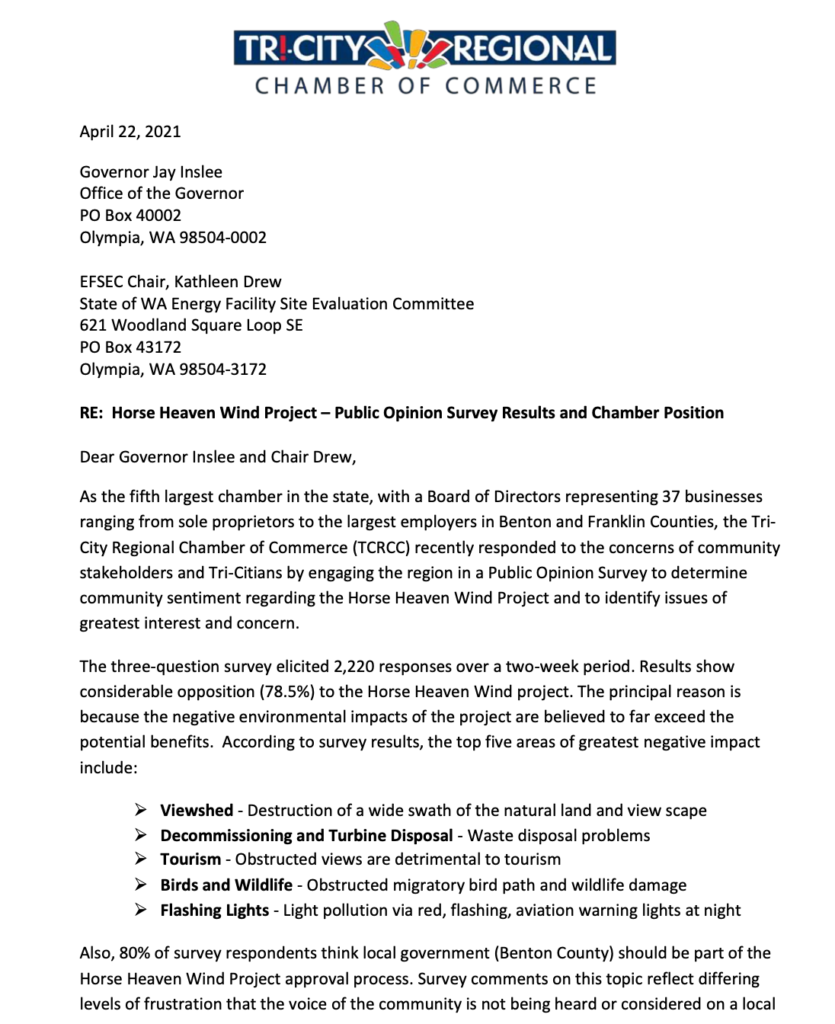
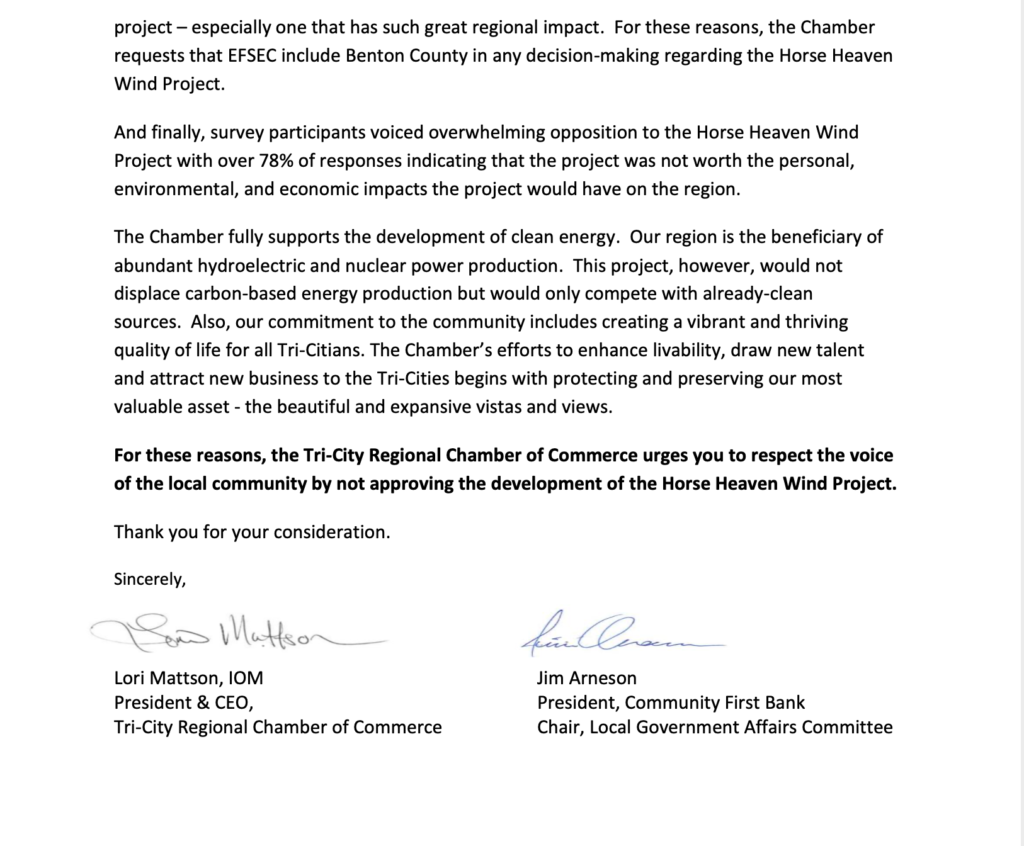
Please find the attached letter from the Mayor and City Council of the City of West Richland regarding the Horse Heaven Wind Farm Project.
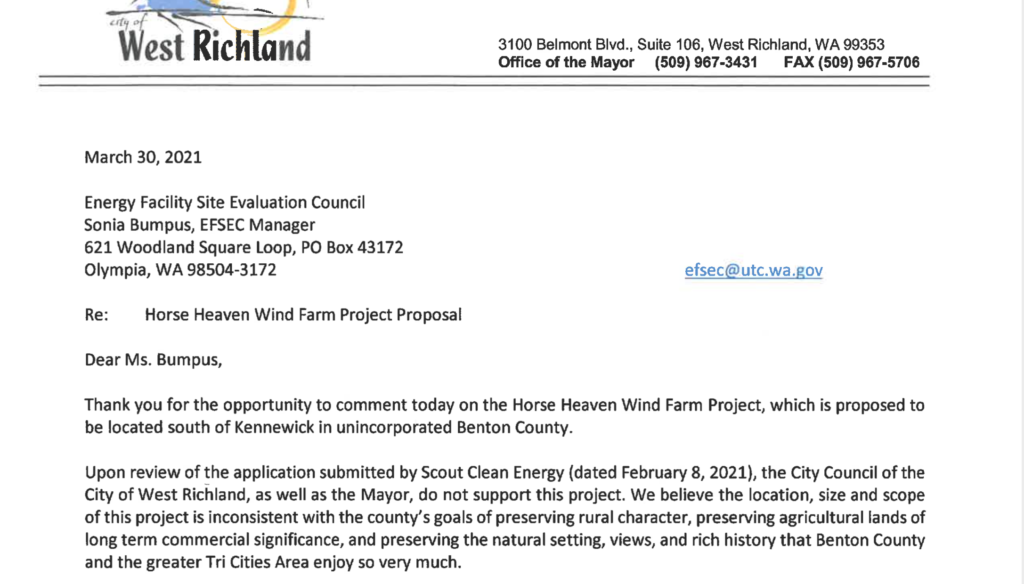
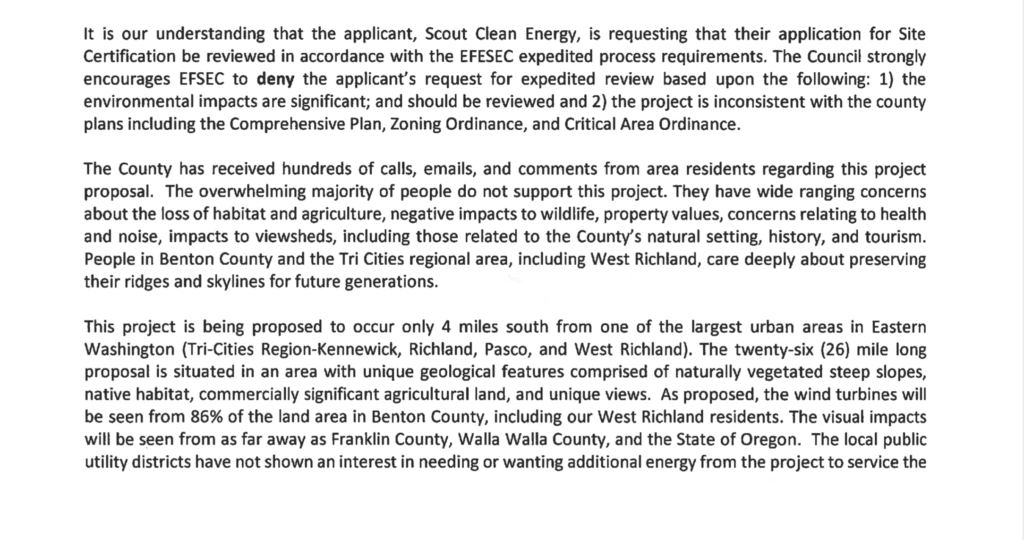
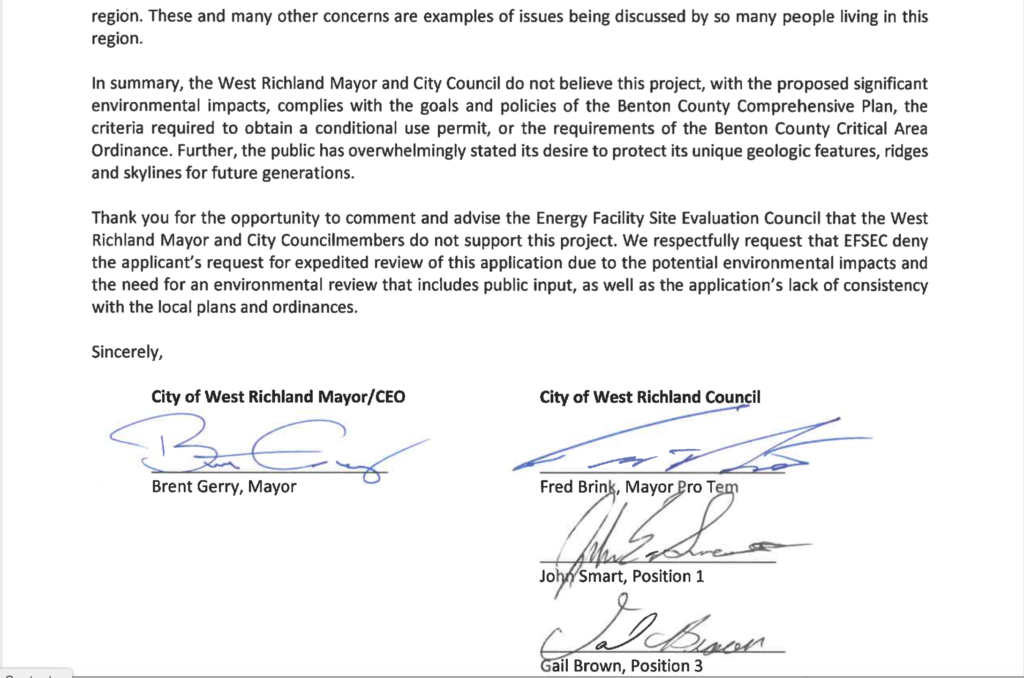
Comments from the Mayor of Kennewick
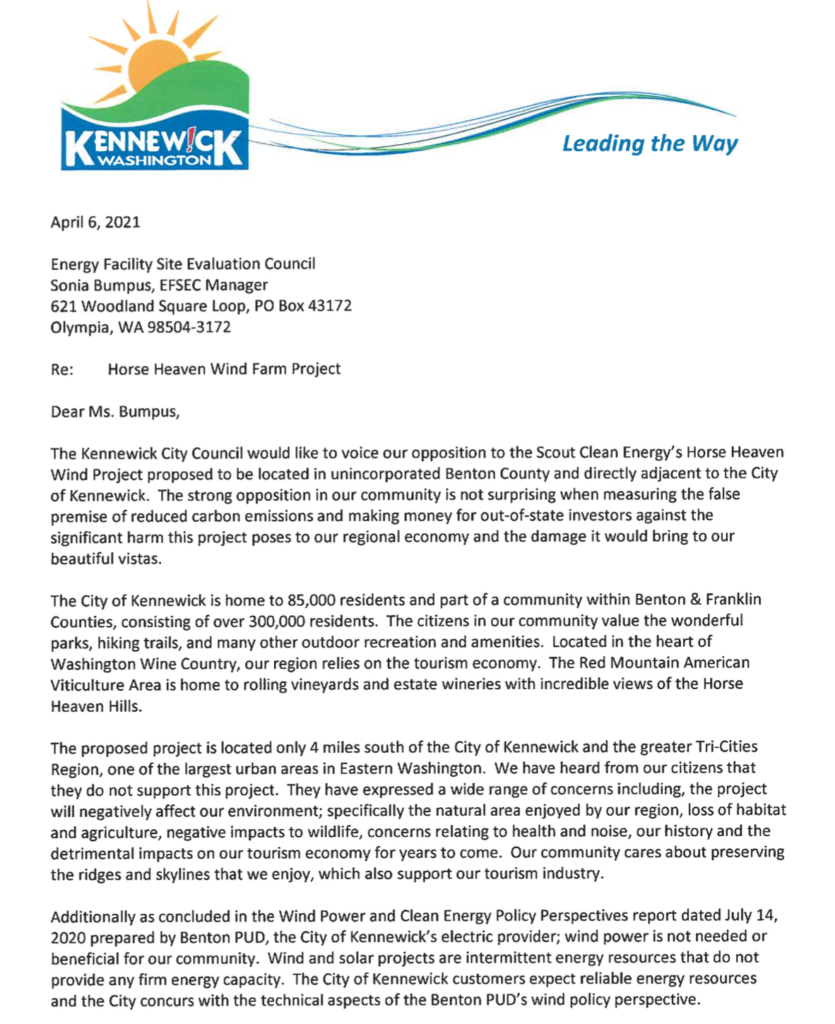
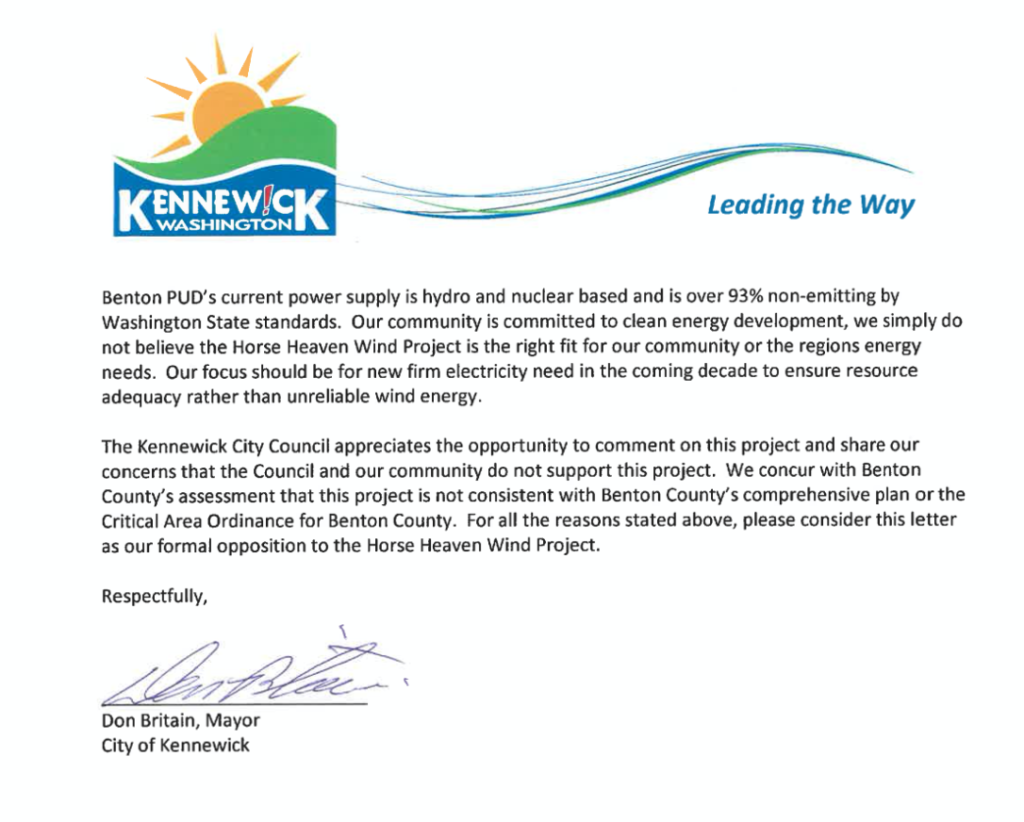
___________________________________________________________________________________________________
Comments submitted by Visit Tri-Cities


Comments from the Mayor of Richland


Comments by William Pennel, retired PNNL Atmospheric researcher


Comments from the Benton County Board of Commissioners


Comments from Christy Hembree



















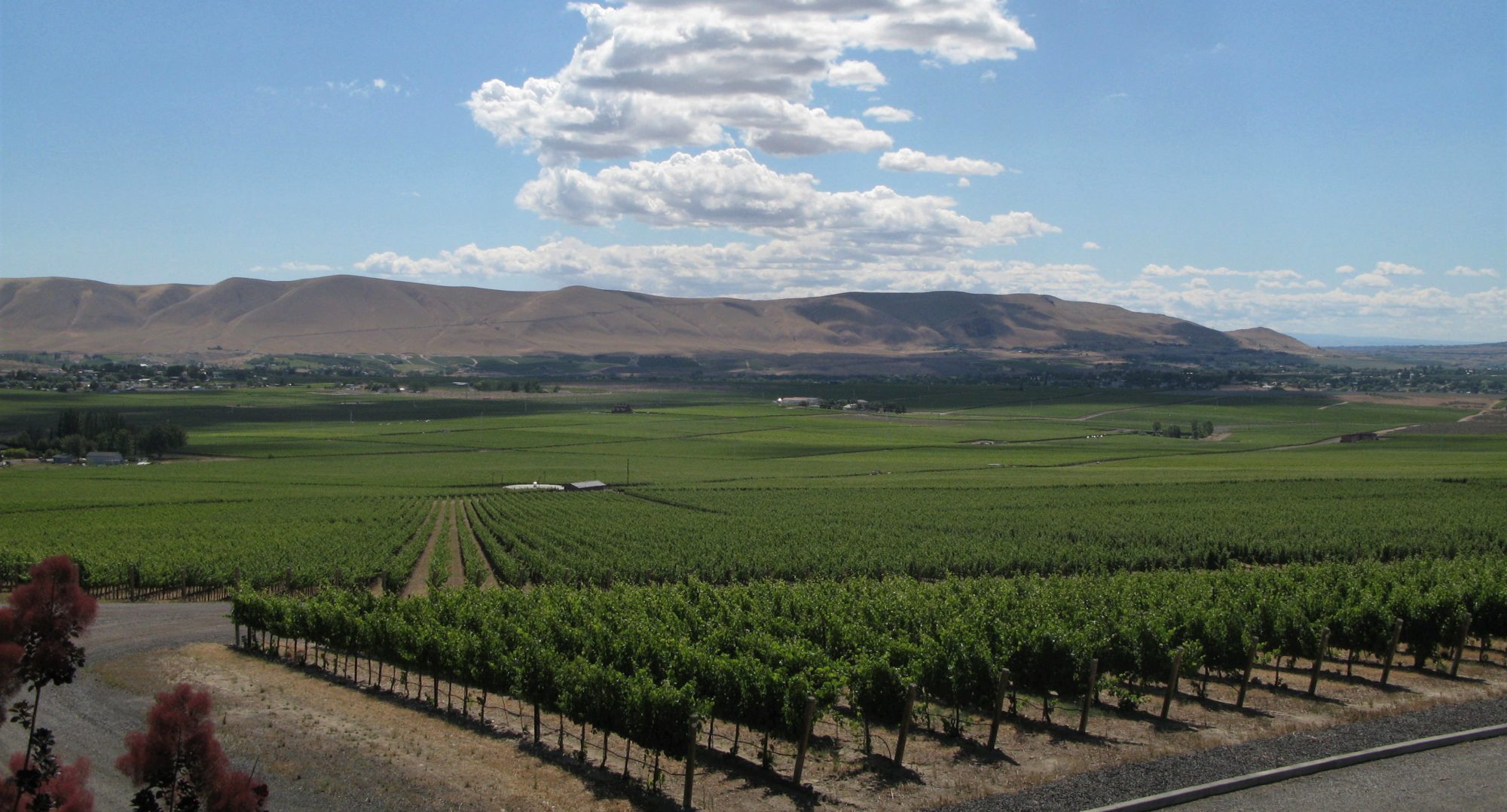
 Users Today : 2
Users Today : 2 Users Yesterday : 5
Users Yesterday : 5 Users Last 7 days : 50
Users Last 7 days : 50 Users Last 30 days : 272
Users Last 30 days : 272 Users This Month : 162
Users This Month : 162 Users This Year : 1542
Users This Year : 1542 Total Users : 16956
Total Users : 16956 Views Today : 2
Views Today : 2 Views Yesterday : 6
Views Yesterday : 6 Views Last 7 days : 60
Views Last 7 days : 60 Views Last 30 days : 347
Views Last 30 days : 347 Views This Month : 198
Views This Month : 198 Views This Year : 2168
Views This Year : 2168 Total views : 32532
Total views : 32532 Who's Online : 0
Who's Online : 0